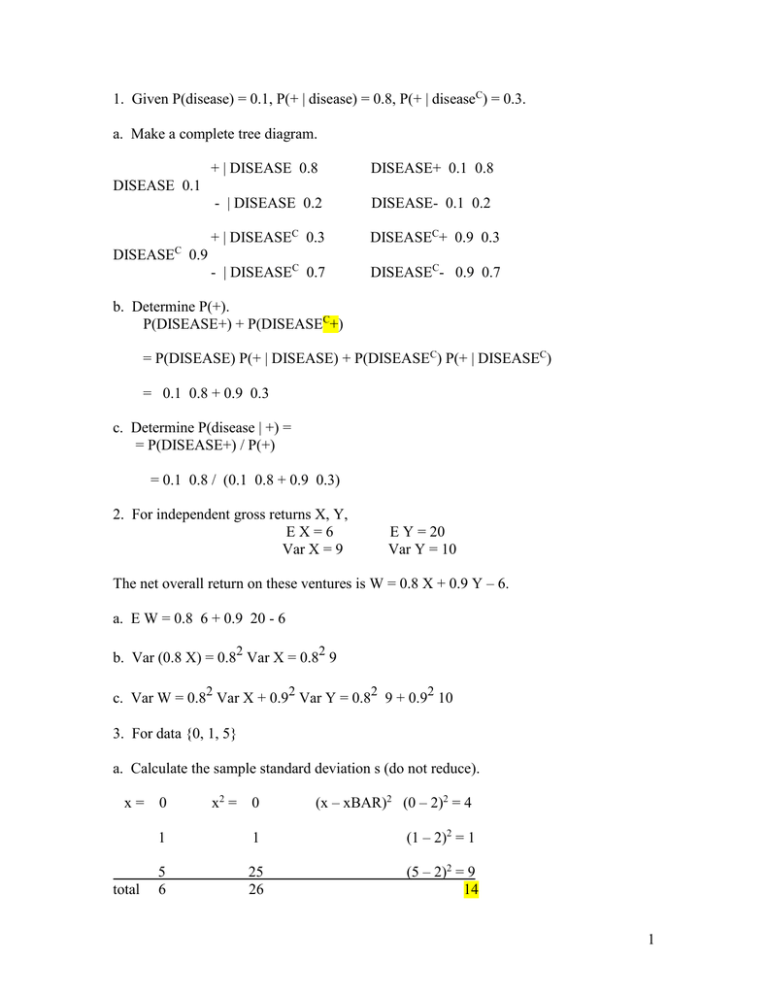1. Given P(disease) = 0.1, P(+ | disease) =... ) = 0.3. a. Make a complete tree diagram.
advertisement

1. Given P(disease) = 0.1, P(+ | disease) = 0.8, P(+ | diseaseC) = 0.3.
a. Make a complete tree diagram.
+ | DISEASE 0.8
DISEASE+ 0.1 0.8
- | DISEASE 0.2
DISEASE- 0.1 0.2
+ | DISEASEC 0.3
DISEASEC+ 0.9 0.3
- | DISEASEC 0.7
DISEASEC- 0.9 0.7
DISEASE 0.1
C
DISEASE 0.9
b. Determine P(+).
P(DISEASE+) + P(DISEASEC+)
= P(DISEASE) P(+ | DISEASE) + P(DISEASEC) P(+ | DISEASEC)
= 0.1 0.8 + 0.9 0.3
c. Determine P(disease | +) =
= P(DISEASE+) / P(+)
= 0.1 0.8 / (0.1 0.8 + 0.9 0.3)
2. For independent gross returns X, Y,
EX=6
Var X = 9
E Y = 20
Var Y = 10
The net overall return on these ventures is W = 0.8 X + 0.9 Y – 6.
a. E W = 0.8 6 + 0.9 20 - 6
b. Var (0.8 X) = 0.82 Var X = 0.82 9
c. Var W = 0.82 Var X + 0.92 Var Y = 0.82 9 + 0.92 10
3. For data {0, 1, 5}
a. Calculate the sample standard deviation s (do not reduce).
x= 0
x2 = 0
(x – xBAR)2 (0 – 2)2 = 4
1
1
(1 – 2)2 = 1
5
6
25
26
(5 – 2)2 = 9
14
total
1
by calc form s = root(3 / 2) root(26 / 3 - 22) = root(7)
by definition s = root(14 / 2) = root(7)
b. Determine the margin of error (ME) for xBAR.
+/- 1.96 s / root(n) = +/- 1.96 root(7) / root(3)
4. For a large sample of size n drawn with replacement from a population having mean
mu, P(mu is covered by xBAR +/- ME) ~ 0.95.
.
5. For the distribution of random variable X
x2 p(x)
x
p(x)
x p(x)
1
0.8
0.8
0.8
4
totals
0.2
1.0
0.8
1.6
3.2
4.0
a. E X = sum of value times probability = 1.6
b. Var X = E X2 – (E X)2
6. We’ve two independent investments. One returns X, the other Y, per dollar invested,
with
E X = E Y = 1.5
Var X = Var Y = 2
a. If we invest two dollars in X we get back 2X. Find the expected value of 2X and its
variance.
E 2X = 2 E X = 2 1.5 = 3
Var 2X 4 Var X = 4 2 = 8
b. If we instead invest one dollar in each of X, Y we get back X+Y. Find the expected
value and variance of X+Y.
E (X + Y) = E X + E Y = 1.5 + 1.5 = 3
Var (X + Y) = (by indep) Var X + Var Y = 2 + 2 = 4
By splitting our $2 investment between x and Y we earn the same expectation as 2X
but with smaller variance (diversification).
7. Draws will be made with equal probability but without replacement from
[ R R R R B B Y]
[4R 2B 1Y]
a. P(R1 Y2 B3) = 4 / 7 1 / 6 2 / 5
draws from
[4R 2B Y] [3R 2B Y] [3R 2B]
b. P(B2) = P(R1 R2) + P(R1C R2) total probability
= P(R1) P(R2 | R1) + P(R1C) P(R2 | R1C)
= 4 / 7 3 / 6 + 3 / 7 4 / 6 = 24 / (7 6) = 4 / 7 same as P(R1)
2
c. P(R2 | B1) = 4 / 6
8. Red and green dice.
a. P(R + G = 4) = P(red green pairs (1, 3), (2, 2), (3, 1)) = 3 / 36
b. E (R + 2) = E R + 2 = 3.5 + 2 = 5.5
9. OIL example with endpoint probabilities
OIL+ 0.2
OIL- 0.1
(c): net from policy “test, drill if +”
-5 – 50 + 200 = 145
-5 – 0 + 0 = -5
OILC+ 0.1 since they total one
-5 – 50 + 0 = -55
OILC- 0.6
-5 – 0 + 0 = -5
a. P(OILC) = 0.1 + 0.6 = 0.7
b. P(+ | OILC) = P(OILC+) / P(+) = 0.1 / (0.2 + 0.1)
c. If cost to test = 5, cost to drill = 50, gross from oil = 200
E( net from policy “test, drill if +” ) = sum of value times probability
= 0.2 145 – 0.1 5 – 0.1 55 – 0.6 5 = 29 - .5 – 5.5 - .5 = 22.5
10. P(A) = 0.2, P(B) = 0.7, events A, B independent.
a. Give a complete Venn diagram.
P(AB) = P(A) P(B | A) = P(A) P(B) = 0.2 0.7 = 0.14 by independence
P(ACB) = P(A) – P(AB) = 0.2 – 0.14 = 0.06
P(ABC) = P(B) – P(AB) = 0.7 – 0.14 = 0.56
P(ACBC) = 1 – 0.14 – 0.06 – 0.56 = 0.24
enclose these labels and values in the ellipses
b. P(A | B) = P(A) = 0.2 by independence
3







